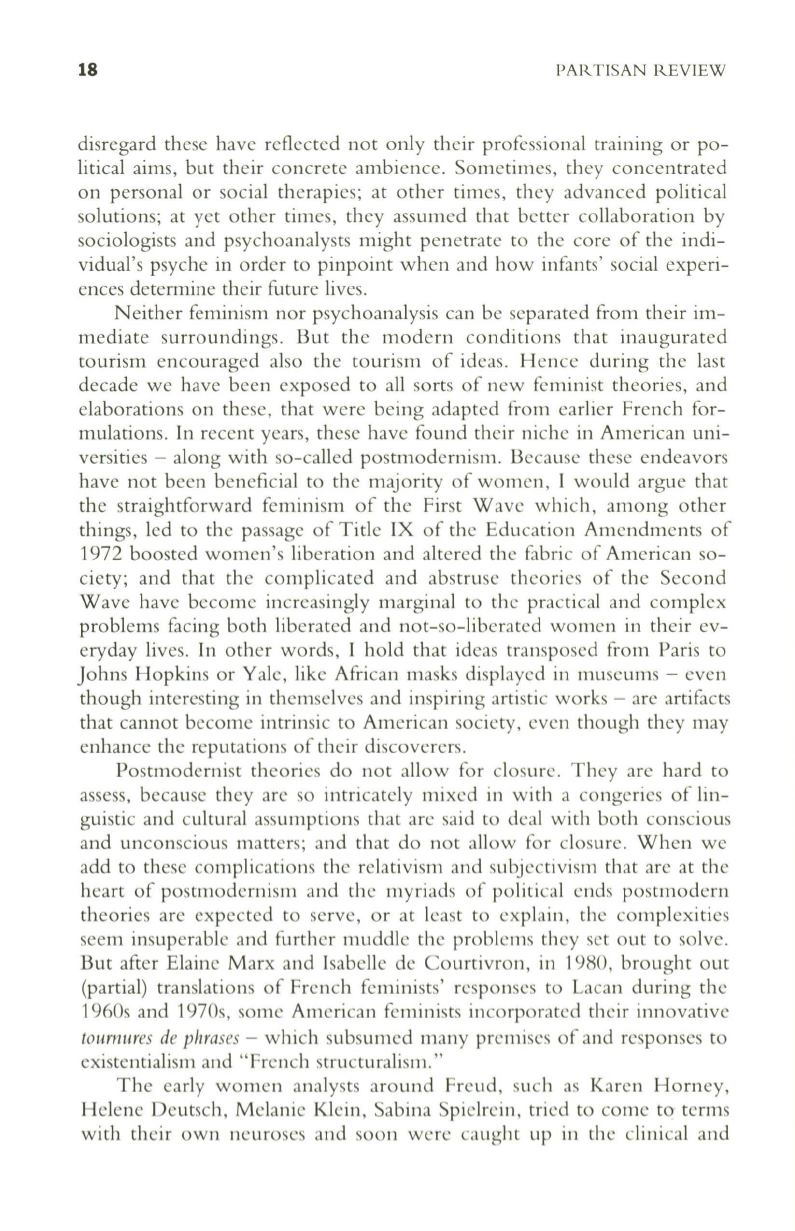
18
PAR.TISAN REVIEW
disregard these have reflected not only their professional training or po–
litical aims, but their concrete ambience. Sometimes, they concentrated
on personal or social therapies; at other times, they advanced political
solutions; at yet other times, they assumed that better collaboration by
sociologists and psychoanalysts might penetrate to the core of the indi–
vidual's psyche in order to pinpoint when and how infants' social experi–
ences determine their future lives.
Neither feminism nor psychoanalysis can be separated from their im–
mediate surroundings. But the modern conditions that inaugurated
tourism encouraged also the tourism of ideas. Hence during the last
decade we have been exposed to all sorts of new feminist theories, and
elaborations on these, that were being adapted from earlier French for–
mulations. In recent years, these have found their niche in American uni–
versities - along with so-called postmodernism. Because these endeavors
have not been beneficial to the majority of women, I would argue that
the straightforward feminism of the First Wave which, among other
things, led to the passage of Title IX of the Education Amendments of
1972 boosted women's liberation and altered the fabric of American so–
ciety; and that the complicated and abstruse theories of the Second
Wave have become increasingly marginal to the practical and complex
problems facing both liberated and not-so-liberated women in their ev–
eryday lives. In other words, I hold that ideas transposed from Paris to
Johns Hopkins or Yale, like African masks displayed in museums - even
though interesting in themselves and inspiring artistic works - are artifacts
that cannot become intrinsic to American society, even though they may
enhance the reputations of their discoverers.
Postmodernist theories do not allow for closure. They are hard to
assess, because they are so intricately mixed in with a congeries of lin–
guistic and cultural assumptions that are said to deal with both conscious
and unconscious matters; and that do not allow for closure. When we
add to these complications the relativism and subjectivism that are at the
heart of postmodernism and the myriads of political ends postmodern
theories are expected
to
serve, or at least to explain, the complexities
seem insuperable and further muddle the problems they set out to solve.
But after Elaine Marx and Isabelle de Courtivron, in 1980, brought out
(partial) translations of French feminists' responses to Lacan during the
1960s and 1970s, some American feminists incorporated their innovative
tournures de phrases
- which subsumed many premises of and responses to
existentialism and "French structuralism."
The early women analysts around Freud, such as Karen Horney,
Helene Deutsch, Melanie Klein, Sabina Spielrein, tried to come to· terms
with their own neuroses and soon were caught up in the clinical and


